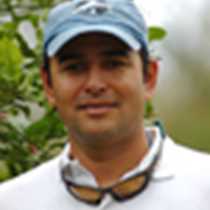Santa Cruz Island
This island is one of the five inhabited islands of the Archipelago. The main town of Puerto Ayora is the tourist capital and operational center of many tour boats. This morning we learned about the conservation and protection efforts of two partners in conservation: the Galápagos National Park Service and the Charles Darwin Research Station. Together they have been functioning since 1959, running successful protection program with reptiles in captivity, both the giant tortoises and the land iguanas. They have done a wonderful job of restoring populations of tortoises that were dangerously close to extinction.
After we walked through town and shopped, local buses took us to the highlands of this middle aged (within the archipelago) island for a delicious lunch in a restaurant surrounded by very lush vegetation. This is an ideal place to observe giant tortoises in the wild, so we spent some time searching for these reptiles. Indeed we saw many of them, some moving at their slow pace, some feeding and of course others were taking a siesta. It was great to watch them in their natural habitat.
On the way back to town we made a stop in the high, humid zone where constant precipitation keeps this area green all year long. When there is no rain, there is still garua here, even during the dry season. Ferns, grasses and mosses are abundant, but the predominant species is Scalesia pedunculata, the tallest member of the Asteracea family found in Galapagos. The Scalesia forest is a perfect habitat for land birds such as some species of Darwin finches and the colorful vermilion flycatcher. Many of us were lucky this afternoon and got a good look at a bright male vermillion flycatcher. We also found the woodpecker finch which is possibly the best known of all the finches due to its habit of using a tool to probe bugs from under tree bark. It has been another successful day in the Archipelago de Colon.
Call +1.800.397.3348 or contact your travel advisor



